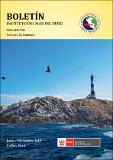Por favor, use este identificador para citar o enlazar este ítem:
https://hdl.handle.net/20.500.12958/3391Registro completo de metadatos
| Campo DC | Valor | Lengua/Idioma |
|---|---|---|
| dc.contributor.author | Aronés Flores, Katia | - |
| dc.contributor.author | Correa Acosta, Jonathan | - |
| dc.contributor.editor | Instituto del Mar del Perú | - |
| dc.date.accessioned | 2019-12-30T21:26:02Z | - |
| dc.date.available | 2019-12-30T21:26:02Z | - |
| dc.date.issued | 2019 | - |
| dc.identifier.citation | Bol Inst Mar Perú. 34(2) 2019: p. 489-502 | es_ES |
| dc.identifier.issn | 04587766 | - |
| dc.identifier.uri | https://hdl.handle.net/20.500.12958/3391 | - |
| dc.description.abstract | Durante el Crucero de Evaluación de la Población de Merluza y otros Demersales 1605-06, efectuado entre el 24 de mayo y 17 de junio 2016, se recolectó 71 muestras de zooplancton con red Hensen de 300 μm de abertura de malla, en arrastres verticales hasta 50 m de profundidad. Los biovolúmenes de zooplancton variaron entre 0,2 y 55,0 mL/muestra, más frecuentes fueron los de menor valor entre 0,1 – 5,0 mL/muestra (39%), los menos frecuentes fueron mayores a 20,0 mL/muestra, ubicados principalmente entre Mórrope y Chicama. Se han determinado 13 especies de eufáusidos con mayores densidades en estadios tempranos como caliptopis (77%) y furcilias (16%) de la abundancia total de este grupo. En el ictioplancton se determinaron 53 familias, siendo las más frecuentes Engraulidae (51%) y Phosichthyidae (35%). La anchoveta fue la especie más abundante representada por huevos (3 y 5.208 huevos/m²) y larvas (3 y 309 larvas/m²), los que se registraron entre Puerto Pizarro y Punta Falsa (huevos), así como entre Talara y Chicama (larvas). | es_ES |
| dc.description.abstract | ABSTRACT: During the Hake and other Demersal Stock Assessment Cruise 1605-06, carried out between May 24 and June 17, 2016, a total of 71 zooplankton samples were collected with a 300 μm Hensen net, in vertical trawls up to a depth of 50 meters. Zooplankton biovolumes varied between 0.2 and 55.0 mL/sample, the most frequent were those of lower value between 0.1 - 5.0 mL/sample (39%), the least frequent were greater than 20.0 mL/sample, located mainly between Mórrope and Chicama. A total of 13 species of euphausiids with higher densities in early stages have been determined, such as calyptopis (77%) and furcilias (16%) of the total abundance of this group. In ichthyoplankton, 53 families were determined, the most frequent being Engraulidae (51%) and Phosichthyidae (35%). The anchoveta was the most abundant species represented by eggs (3 and 5,208 eggs/m²) and larvae (3 and 309 larvae/m²), which were recorded between Puerto Pizarro and Punta Falsa (eggs), as well as between Talara and Chicama (larvae). | - |
| dc.language.iso | spa | es_ES |
| dc.publisher | Instituto del Mar del Perú | es_ES |
| dc.relation.ispartofseries | Boletín IMARPE 34(2), 2019; | - |
| dc.rights | info:eu-repo/semantics/openAccess | es_ES |
| dc.rights.uri | https://creativecommons.org/licenses/by/4.0/ | es_ES |
| dc.source | Instituto del Mar del Perú - IMARPE | es_ES |
| dc.source.uri | Repositorio Digital IMARPE | es_ES |
| dc.title | Biovolúmenes del zooplancton. Distribución y abundancia de eufáusidos e ictioplancton frente a la costa peruana. Otoño 2016 | es_ES |
| dc.title.alternative | Zooplankton biovolumes. Distribution and abundance of euphausiids and ichthyoplankton off the Peruvian coast. Autumn 2016 | es_ES |
| dc.type | info:eu-repo/semantics/article | es_ES |
| Aparece en las colecciones: | Boletín 34(2), 2019 | |
Ficheros en este ítem:
| Fichero | Descripción | Tamaño | Formato | |
|---|---|---|---|---|
| Boletin 34(2)-12.pdf | 1,48 MB | Adobe PDF |  Visualizar/Abrir |
Este ítem está sujeto a una licencia Creative Commons Licencia Creative Commons

